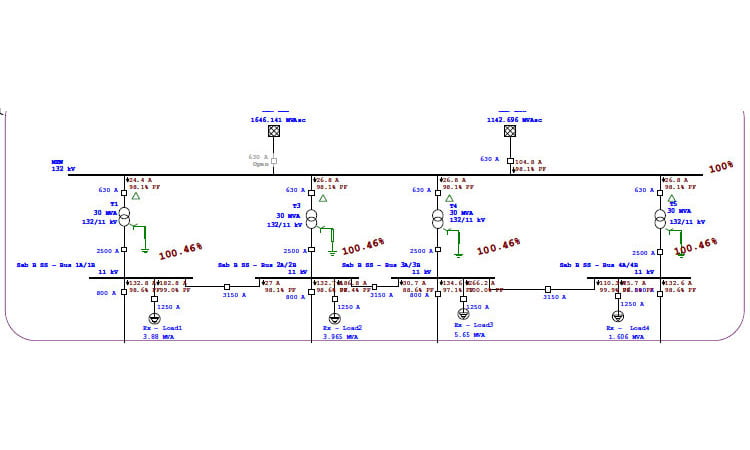Power system simulation involves power grid modeling and network simulation to research electrical power grids using design/offline or real-time data.
Calculations and simulations are performed to verify that the electrical power grid including the system components like generators, lines, transformers, shunt elements, perform as intended, withstand the expected stress, and guard against failures. ETAP is one of the best Power system simulation software.
Care Labs is a competent provider of Power System Analysis for Load Flow, Short Circuit, and Relay Coordination and Certification services.
Why power system simulation is for load flow, short circuit, and relay coordination is done?
Performing a power flow simulation study helps to plan ahead and account for various hypothetical situations.
For example, if a power supply cable is to be taken off for maintenance, simulations help to identify the remaining lines in the system. So it helps to handle the required loads without exceeding their rated values.
For the safe operation system relay coordination stimulation is performed and it helps the system to function correctly, to avoid nuisance tripping, protection could also be a serious concern in any industry.
Benefits of Power System study and analysis
- Helps to Increase the levels of safety
- More efficient use of resources
- Clarification of electrical safety responsibilities
- The identification and elimination of safety hazards
- Compliance with regulations and statutory requirements
- Improvement of employee morale
- Ensuring longevity of your expensive equipment
- Creation of effective cycle of safety improvement
Power system simulation software is a category of simulation programs that specialize in the operation of electric power systems.
The computer programs are utilized in a good range of designing and operational situations for
- Electric power generation – Nuclear, Conventional, Renewable
- Commercial facilities
- Utility transmission
- Utility distribution
- Railway power systems
- Industrial power systems
The power system study and analysis includes long-term generation and transmission expansion planning, short-term operational simulations.
These programs typically make use of mathematical optimization techniques such as applied mathematics, quadratic programming, and mixed-integer programming.
How is Simulation for Load Flow, Short Circuit, and Relay Coordination Done?
Power System Study and Analysis Process
- Collecting the data
- Implementing power grid modeling using electric power system analysis software like ETAP
- Determination of load flow analysis.
- Determination of Short Circuit Study.
- Determination of Stability Study.
- Document review.
- Management Briefing
- Draft Report Submission
- Final Report Submission
Power System Study and Analysis Software
ETAP is an electrical network modeling and simulation software tool that helps power systems engineers to provides an electrical digital view and analyze electrical power systems.
ETAP was developed for utilization on MS-DOS OS and intended for commercial and atomic power system analysis and system operations.
Power system simulation requires an electrical digital twin consisting of an influence system network model that has system connectivity, topology, device characteristics, historical system response, and real-time operations data to make offline or online decisions.
ETAP performs numerical calculations with high speed. It automatically applies the industrial accepted standards and provides the output reports.
ETAP provides a systematic tool to solve the coordination problem of over current relays in the radial system. ETAP can able to handle 1000 buses that contain a load schedule program which tracks up to 10,000,000 load items.
Key Features of ETAP
- Multi-console with multi-screen monitoring
- Graphical monitoring via ETAP one-line diagram
- Visual monitoring via Man-Machine Interface (MMI)
- Alarm warnings with a graphical interface
- Alert of equipment out-of-range violations
- Monitoring of electrical & non-electrical parameters
Standards & Guidelines
International standards and native regulations form the idea for the evaluation of calculation and simulation results for power system designs. It includes requirements and proposals for a cover of personnel and equipment, system response, and equipment performance.
NEC 110 requires that a brief circuit analysis finished all electrical equipment and panels. The most adopted standards for circuit analysis are the ANSI/IEEE C37.010-1979 standard moreover the International Electrotechnical Commission (IEC) 60909 standard is also accepted.
Contact us to get your power system study and analysis report today!
